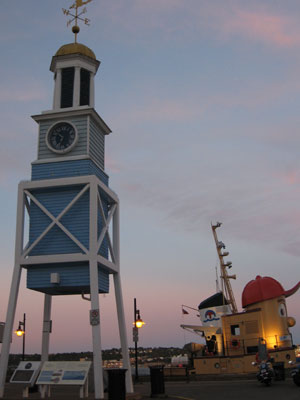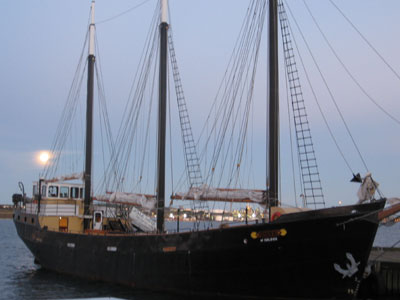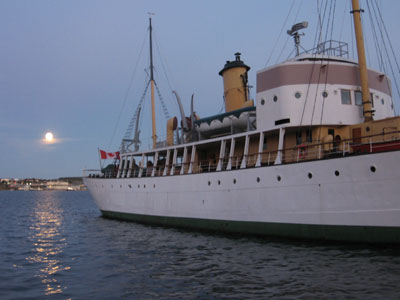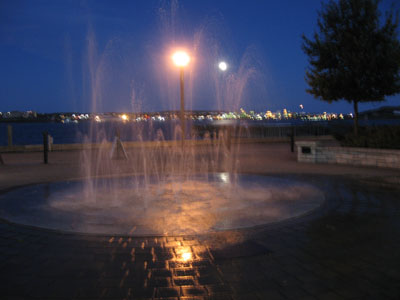|
October 6, 2006
Hello from Nova Scotia: Arrival in Halifax
and Celebrating Four Cultural Histories in a Musical Production
Called "DRUM!"
Slowly but surely my Nova Scotia discoveries were coming to an
end. I only had one evening and one full day left after discovering
the South West portion of this province over the last four days,
following my last stops along the South Shore in Lunenburg
and Peggy’s Cove. As I rolled
into town late in the afternoon I noticed the landscape: lots of
lakes and waterways interspersed with low-lying hills. One of my
first impressions was that many of the neighbourhoods had beautiful
houses with well-kept gardens and established trees. Halifax presented
itself as a very picturesque city. I did not have a Halifax city
map on me, but I figured if I only headed east I’d hit the
oceanfront sooner or later, which I did right near Pleasant Point,
one of Halifax’ largest public parks. A friendly local gentleman
redirected me to downtown Halifax to Barrington Street which is
where my abode for two nights, the Delta
Barrington Hotel, was located.

Halifax harbour view
With his directions I was able to make my way downtown and had
no problem finding my hotel. I breezed through check-in and went
upstairs to my room to relax for a bit and take advantage of the
in-room high-speed Internet connection. After refreshing myself
I was ready for an evening of discoveries and I started to stroll
down to the waterfront.
With its strategic location on the Atlantic Ocean, Halifax is the
capital of Nova Scotia and Eastern Canada’s most important
seaport. With an estimated population of roughly 385,000 residents
throughout the metropolitan area, Halifax is Atlantic Canada’s
largest population centre and a major economic centre on Canada’s
east coast. Major employers include the Department of National Defense
(Halifax has had a military role for several centuries due to its
strategic location), the Port of Halifax, various government services
and private sector companies. Several universities are located here
including Dalhousie University, Saint Mary’s University and
Mount Saint Vincent University.

Halifax harbour view
Halifax dates back more than two and a half centuries: it was founded
in 1749, as the shire town of Halifax County and the provincial
capital. It was originally established by the British to provide
a counter-balance to the French presence in Quebec and Acadia (present-day
New Brunswick, Prince Edward Island, Cape Breton Island and the
Gaspé Peninsula). Today’s Halifax Regional Municipality
includes the neighbouring cities of Dartmouth and Bedford since
amalgamation in 1996.

Halifax harbour view
The coastline of the Halifax Regional Municipality encompasses about
400 km and is heavily indented with numerous deeps inlets protruding
into the countryside. The topography is varied and ranges from lush
farmland in the outlying regions to forested rolling hills. The
climate is more moderate than in Central Canada and temperatures
generally vary between about -5 degrees Celsius in the winter and
23 degrees Celsius in the summer.

Halifax harbour view
Halifax is well-known for its cultural offerings which are enhanced
by the large concentration of post-secondary students. Its music
scene in particular is very vibrant and in recent years, Halifax
has also become an important film production centre. The city itself
is the largest growing area in the Maritimes and is connected to
the rest of Canada and the world through a major airport. Via Rail’s
eastern terminus is located in Halifax.

Halifax harbour view
I headed straight east from my hotel via Duke Street to the waterfront
to a complex called “Historic Properties” – a
collection of historic buildings that was restored and redeveloped
in the early 1970s. Many of the buildings in this complex are former
warehouses of the privateers, pirates who were licensed by the British
crown to raid enemy vessels. They brought back plentiful bounty
that was stored in these warehouses. One of the most famous of these
privateers was a fellow name Enos Collins, who started the Halifax
Banking Company, the first bank in Nova Scotia.
Right at the foot of Duke Street, next to the Metro Transit Ferry
Terminal that takes you over to Dartmouth, I discovered one of Halifax’
treasured icons: Theodore Too is a tugboat modeled after a popular
character in a Canadian children’s television show named “Theodore
Tugboat”. Today the Theodore Too is available for harbour
tours, private charters, birthday parties and school groups.

Theodore Too, a Halifax icon
I headed further south along the waterfront along “Harbourwalk”,
Halifax’s famous Waterfront Trail. The sun had already set
and the moon was shining over the picturesque Halifax Harbour. My
destination was Pier 20, location of the celebrated show “DRUM!”,
a musical presentation of Nova Scotia’s four founding cultures.
I reached the location about half an hour before show time and people
were already lining up in the common areas outside the theatre.

Southern entrance to Harbourwalk
Right around 8 pm I took my seat and fortunately I was located right
in the front row on the right side of the stage. The idea behind
DRUM! is to shine a light on Nova Scotia’s four principal
cultures: Black, Acadian, Aboriginal and Celtic. The evening began
with a dramatic performance of aboriginal musicians playing their
drums and singing an introductory song in their native Mi’kmaq language.

The Drum! Theatre
They were joined by an entire ensemble of musicians, dancers and
singers who came on stage to share their music and from that point
forward the entire evening was a beautiful carousel of music and
song from four different cultures. The sophisticated lighting, video
images and narrated poetry underscored the symbolic content of this
performance that challenged the senses on every level.

An amazing performance
DRUM! was
originally conceived as a 45 minute tourism promotion piece as the
main stage show at Tall Ships 2000, a special racing event that
featured sailing vessels from all over the world. In 2004 DRUM!
was turned into a full-length production and performed for ten nights
in its specially designed theatre at the Halifax waterfront. The
current run of DRUM! in Halifax will be followed by a tour through
the United States starting in Florida and finishing in Utah. A tour
of Ontario and Saskatchewan will follow in May, and the production
will return to the Halifax waterfront in September of 2007.

Image of DRUM!
The performance unfolded as one heart-pumping combination of music,
dance, poetry, video, rhythm and song. At one point three of the
female performers got up on stage and sang a-capella in the most
beautiful harmonies one can imagine. My breath was taken away by
their performance. Acadian washboards, Celtic fiddles and bagpipes,
Aboriginal drums and sultry black voices came together to celebrate
FOUR CULTURES….. FOUR RHYTHMS…..ONE HEART.

Image of DRUM!
The sold-out audience was captivated by these talented performers,
the beauty of their music and their message. After the last extended
standing ovation I left the theatre elated, moved and inspired,
ready for another final day of discoveries in Halifax.
DRUM! was breathtaking in its theatrical beauty and its musical
performance, and its message still resonates with me. I ended up
buying the CD of this production to take this beautiful music and
its spirit home with me to Toronto.

Image of DRUM!
Here at Travel and Transitions we celebrate cross-cultural connections
and understanding, and DRUM! was as perfect a musical representation
of this spirit as I have ever seen. DRUM! communicates a message
to the world: “We can hold on to who we are and still
share a song, a stage, a country, a world.”
It doesn’t get any better than that….

Useful
books about travel to Nova Scotia:
Related
articles:
My
five whirlwind days in Nova Scotia
Acadian
history at the Grand Pré National Historic Site
400 years of history at Annapolis
Royal
Port-Royal, a French habitation from 1605
Dinner at the Garrison House
in Annapolis Royal
The Annapolis Royal
Graveyard Tour
The Garrison House Bed and Breakfast
Exploring the Evangeline Trail from
Annapolis Royal to Yarmouth
Learning about Mi'kmaq heritage at the
Bear River First Nation Heritage and Cultural Center
Victorian heritage in Yarmouth
The MacKinnon-Cann Inn: Where Home
and Garden Television meets the Travel Channel
Yarmouth explained - the Yarmouth
County Museum
My car is in the ditch in Chebogue
River
The Lighthouse Trail from Yarmouth
to Shelburne
The Lighthouse Trail from Shelburne
to Lunenburg
The Town of Lunenburg - a UNESCO World Heritage
Site
An interview with the owners of the
Lunenburg Inn
The Lighthouse Trail from Lunenburg to
Halifax via Mahone Bay and Peggy's Cove
Arrival in Halifax and a stunning
musical performance - DRUM!
A Halifax city tour, the city's
connection to the Titantic and the 1917 Halifax Explosion
Exploring the Halifax Harbourwalk and
Pier 21 - Canada's immigration museum
A ferry trip to Dartmouth and saying
goodbye to Halifax
An interview with Pier 21 -
Canada's immigration museum
Helpful
links for travel to Nova Scotia:
Tourism
Nova Scotia
Destination
South West Nova Scotia
Halifax Tourism
|